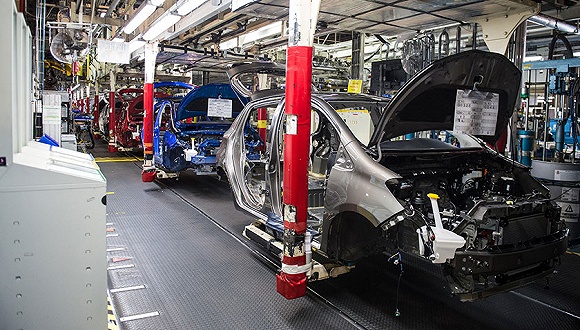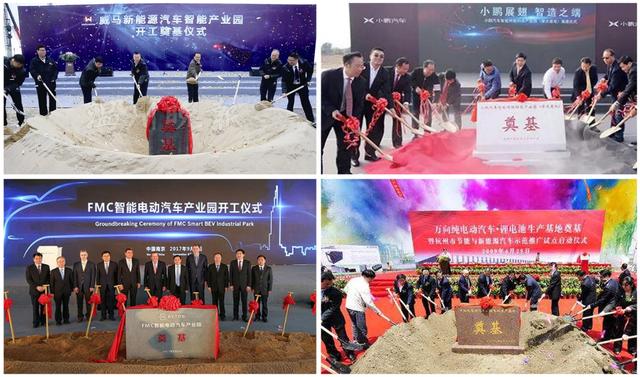The dilemma of car OEM: The boom of building a car or building a factory will waste a lot of social resources
Building a new car factory is not a social problem. Many production lines have been shut down for work, and many people are anxious to continue building factories. This is a strange situation in China's auto industry. Sima Hui, the owner of Weima, has a point of view. He must build his own factory and must not use OEM methods. According to Bi Fukang, CEO of Co-Founder, the company's co-founder: “If you want to build a car, you must have a factory that meets the “Industry 4.0†standard. Now that the traditional car company does not have a factory that meets the 4.0 standard, it is necessary to build such a standard on its own. In fact, even if there are, high-standard factory equipment will mostly be left to own production of their own models, will not give others to OEM. However, the overall industry in China's auto manufacturing industry is in surplus. New car manufacturers have invested in building factories, which will undoubtedly put the entire industry in a serious waste of resources. Li Bin, the founder of Weilai Automobile, put forward in many public occasions: "We have to repeat the construction of a production plant when there are so many redundant high-quality production capacity in the country. This is a waste." Weimar and Weilai represent different schools. Whose point of view is more practical? From the big Chinese constructors' pattern, who can become the mainstream development idea? New vehicle builders surged to build climax Weima laid the foundation for the Wenzhou plant on November 23, 2016. After a total of 492 days in 16 months, the production line was successfully completed. The total area of ​​the plant is close to 1,000 mu. The total investment of the first-phase project is planned to be 6.7 billion yuan. The planned annual production capacity is 100,000 units. Besides the four major workshops for stamping, welding, painting, and assembly of traditional automobile production, there are also The battery pack and plastic parts production workshop supports advanced production processes such as aluminum body manufacturing and automated welding. Xiaopeng chose to build a factory in Zhaoqing, Guangdong Province, and planned to use 3,000 mu of land, including 600 mu of land in the first phase and an investment of 4 billion yuan. After the first phase of the project is completed and put into production, Xiaopeng Automobile is expected to have an annual production capacity of 100,000 new intelligent energy vehicles and create more than 3,000 jobs. The second phase covers an area of ​​1,000 mu with an investment of 6 billion yuan. The total investment for the two phases is as high as 10 billion yuan; in addition, 1400 acres of land will be reserved for the production of smart car industry and ecological supporting projects. In fact, around the construction of the Weilai car, the industry has been mad for many years, there are arguments, Weilai choose to build a factory in Shanghai, there are also said to find Changan, Guangzhou Automobile OEM, but from now on, Weilai will step It is practical to produce in Jianghuai. The industry has been ridiculed by Tesla as a plagiarism in the industry. The Ranger car of PPT Construction started a super factory with an annual production capacity of 200,000 vehicles in Huzhou, Jiangsu last year. The total investment in the project is said to be 11.5 billion yuan. BYTON has a total investment of approximately RMB 11.07 billion in Nanjing, covers an area of ​​approximately 1600 acres, has a total construction area of ​​approximately 500,000 square meters, and has a planned annual production capacity of 300,000 units. The planned production capacity of 100,000 units in the first phase is scheduled to be completed in 2019. Put into production. At the end of 2016, Wanxiang Group's "50,000-Year-Range Project-Extended Pure Electric Passenger Car Project" was approved by the National Development and Reform Commission and started construction. Unfortunately, Mr. Lu Guanqiu passed away in October 2017, and the pace of making Wanxiang's car manufacturing may be Festival branches. China's existing excess overcapacity In 2009, China's auto market re-emerged in the blowout market, becoming the world's largest car producer and the largest automotive market in one fell swoop. There are 27 provinces, autonomous regions and municipalities in China that build automobiles. All regions have classified automobiles as pillar industries. By 2018, China's auto production capacity will reach 40 million, and by 2020 it will reach 50 million. In 2015, China’s auto overcapacity is not yet serious, but with the continuous production of capacity under construction and the market unable to absorb, there will be serious overcapacity in the next few years. However, the problem is that the pure marketization of social resources is difficult to adjust. The Detroit's capacity lessons from the American Automobile City have been verified and market regulation is not a panacea. [Large trip] learned that the current problem of China's auto manufacturing industry is becoming more and more serious. On the one hand, it is a production process. A large number of production lines are suspended and workers are waiting for work. On the other hand, many companies are desperately building new plants. In the first half of this year, FAW-Volkswagen's four new workshops and factories were completed and will soon be put into production. They are the first phase of the Tianjin factory, the first phase of the Qingdao factory, the first phase of the Changchun Q factory, and the second phase of the Foshan factory. After these new workshops are put into production, they will reach an annual production capacity of 1.1 million vehicles/year, and FAW-Volkswagen's domestic total annual production will be about 2 million vehicles. Only one brand of FAW-Volkswagen has reached an annual output of over 3 million vehicles. The Changchun Q plant will undertake the production of the Audi Q5L, and the Qingdao plant will become the main manufacturing base for the new Bora models. The FAW-Volkswagen SUV Songs with SAIC-Volkswagen Tiguan PK will be produced in Foshan. These production lines are also important weapons for Volkswagen in China. In the past three years, Volkswagen and Audi have taken a lot of market momentum in the Chinese market by German brothers Mercedes and BMW. In addition to the introduction of good models, the public understands that adequate production capacity is also very important. Similar to the situation of the general public, Dongfeng Honda, FAW Toyota, GAC Toyota are also the same, these car prices in China are in short supply, basically selling more than capacity, in a state in short supply. In 2016, Dongfeng Honda’s sales volume soared by 40% to more than 570,000 units. In the current period, Dongfeng Honda’s saturation capacity was less than 480,000 units, and the emergency expansion of the plant was close to 600,000 units of annual capacity. Since last year, some workshops in East Benpo have been implemented in three shifts, with 24 hours of uninterrupted production. In this way, there was also a "zero inventory of existing cars" in the second half of the year. In 2017, Dongben continued to expand its production capacity to 720,000 vehicles, and it is expected to increase 20,000 vehicles this year. In 2017, Guangzhou Automobile's sales volume reached 440,000 vehicles, and its production capacity was only 380,000. This year, GAC Toyota's third production line will be in Nansha, Guangzhou, with an annual production capacity of 100,000 vehicles and will exceed 200,000 vehicles in the future. FAW Toyota has three plants in Changchun, Tianjin, and Sichuan, with a total annual production capacity of approximately 700,000 vehicles. However, it still cannot meet demand and is also expanding production. Sales of domestic brands such as Geely and Great Wall are also increasing, and production capacity is also expanding. But not all people are at a feast. Unlike mass-vehicle companies such as Volkswagen, Toyota, Toyota, Geely, Great Wall and best-selling vehicles, most of the small and medium-sized car companies and even some of the international giants' marginal brands are still in production. Work status For example, Changan Citroen DS brand, production line planning is 200,000 production capacity, but last year produced only 5,800 vehicles. Another example is that Beijing’s Hyundai has suffered a great deal. Due to the influence of Sino-Korean relations, Beijing’s five modern factories plan production lines for 1.65 million vehicles a year. Last year, sales volume was only 820,000, and the operating rate was less than half. In this situation, Beijing’s modern factories did not dare to expand production, but they were also reluctant to change production. Because of concern that once the Sino-South Korean relations turn warmer, Hyundai’s sales will increase significantly, and there will be no opportunity to provide production capacity. Caused by the new force companies to desperately build new plants, this view from the perspective of macro-industry, has buried a huge hidden waste of social resources. Henan Dongfanglong Machine Manufacture Co., Ltd , https://www.dfloilm.com
